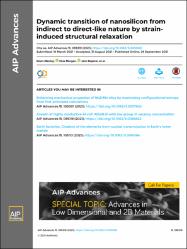| dc.contributor.author | Mantey, Kevin | |
| dc.contributor.author | Morgan, Huw | |
| dc.contributor.author | Boparai, Jack | |
| dc.contributor.author | Yamani, Zain | |
| dc.contributor.author | Bahçeci, Ersin | |
| dc.contributor.author | Nayfeh, Munir Hasan | |
| dc.date.accessioned | 2021-12-27T06:24:05Z | |
| dc.date.available | 2021-12-27T06:24:05Z | |
| dc.date.issued | 2021 | en_US |
| dc.identifier.citation | Mantey, K., Morgan, H., Boparai, J., Yamani, Z., Bahceci, E., Nayfeh, M.H. (2021). Dynamic transition of nanosilicon from indirect to direct-like nature by strain-induced structural relaxation. AIP Advances, 11 (9), art. no. 095319.
https://doi.org/10.1063/5.0050581 | en_US |
| dc.identifier.uri | https://hdl.handle.net/20.500.12508/1976 | |
| dc.identifier.uri | https://doi.org/10.1063/5.0050581 | |
| dc.description.abstract | Silicon nanoclusters exhibit light emission with direct-like ns-mu s time dynamics; however, they show variable synthesis and structure, optical, and electronic characteristics. The widely adopted model is a core-shell in which the core is an indirect tetrahedral absorbing Si phase, while the shell is a network of re-structured direct-like H-Si-Si-H molecular emitting phases, with the two connected via back Si-Si tetrahedral bonds, exhibiting a potential barrier, which significantly hinders emission. We carried out first-principles atomistic computations of a 1-nm Si nanoparticle to discern the variabilities. Enlarging the network reduces the potential barrier monotonically to a finite limit not sufficient for strong emission to proceed while inducing a path to quenching of emission via a conical crossing between the excited and ground states. However, enlarging the network is found to induce strain and structural instability, which causes structural relaxation that creates a direct path for emission without crossing the barrier. Following emission, the particle relaxes back to the indirect ground structure, which completes the cycle. The results also confirm the pivotal role of HF/H2O2 etching in synthesizing the core-shells and affording control over the molecular network. Measurements using synchrotron and laboratory UV excitation of thin films of 1-nm Si particles show good agreement with the simulation results. It is plausible that the relaxation is behind the stimulated emission, gain, or microscopic laser action, reported earlier in macroscopic distributions of 1- and 3-nm Si nanoparticles. | en_US |
| dc.language.iso | eng | en_US |
| dc.publisher | AIP Advances | en_US |
| dc.relation.isversionof | 10.1063/5.0050581 | en_US |
| dc.rights | info:eu-repo/semantics/openAccess | en_US |
| dc.subject.classification | Science & Technology - Other Topics | |
| dc.subject.classification | Materials Science | |
| dc.subject.classification | Physics | |
| dc.subject.other | Hydrogenated silicon clusters | |
| dc.subject.other | Zeta valence quality | |
| dc.subject.other | Surface reconstruction | |
| dc.subject.other | Absorption-spectrum | |
| dc.subject.other | Quantum confinement | |
| dc.subject.other | Nanoparticles | |
| dc.subject.other | Atoms Li | |
| dc.title | Dynamic transition of nanosilicon from indirect to direct-like nature by strain-induced structural relaxation | en_US |
| dc.type | article | en_US |
| dc.relation.journal | AIP Advances | en_US |
| dc.contributor.department | Mühendislik ve Doğa Bilimleri Fakültesi -- Metalurji ve Malzeme Mühendisliği Bölümü | en_US |
| dc.identifier.volume | 11 | en_US |
| dc.identifier.issue | 9 | en_US |
| dc.relation.publicationcategory | Makale - Uluslararası Hakemli Dergi - Kurum Öğretim Elemanı | en_US |
| dc.contributor.isteauthor | Bahçeci, Ersin | |
| dc.relation.index | Web of Science - Scopus | en_US |
| dc.relation.index | Web of Science Core Collection - Science Citation Index Expanded | |
















